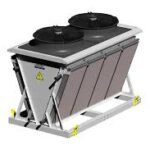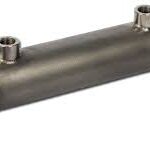Tube in Tube Heat Exchangers
Tube in Tube Heat Exchangers consists of two concentric tubes where one fluid flows through the inner tube and another fluid flows through the annular space between the inner and outer tubes. This design maximizes surface area for efficient heat transfer between the fluids, making it suitable for diverse applications in heating, cooling, and industrial processes.

Tube in Tube Heat Exchangers
Key Factors
- Heat Transfer Efficiency:
- Maximizing the surface area available for heat transfer between the two fluids.
- Ensuring proper fluid flow patterns (parallel or counter-current) to optimize thermal exchange.
- Construction and Mechanical Design:
- Determining the dimensions (diameter, length) and configuration (straight or coiled tubes) based on space constraints and performance requirements.
- Providing adequate support and structural integrity to withstand operational stresses and maintain alignment.
- Thermal Performance:
- Considering insulation and jacketing options to minimize heat loss and maintain thermal efficiency.
- Designing for uniform temperature distribution across the heat exchanger to prevent hot spots or thermal gradients.
- Maintenance and Cleanability:
- Incorporating features such as access ports, removable covers, or cleaning mechanisms to facilitate routine maintenance and prevent fouling.
- Designing for ease of inspection and repair to minimize downtime and maximize operational uptime.
- Safety and Regulatory Compliance:
- Adhering to applicable industry standards and regulatory requirements for pressure vessels, materials, and safety protocols.
- Designing for reliable operation under all foreseeable conditions to ensure the safety of personnel and equipment.
- Environmental Considerations:
- Evaluating the environmental impact of materials used and energy consumption associated with heat exchanger operation.
- Incorporating sustainability practices where feasible, such as energy-efficient designs or use of recyclable materials.
Tube in Tube Heat Exchangers
Specification
| DRAUGHT TYPE/ SHAPE | FLOW TYPE | MOC (Material of Construction) | CAPACITY (TR) | FILL TYPE | DRIVE TYPE |
|---|---|---|---|---|---|
| Induced / Square | Counter Flow | Stainless Steel | 10 – 500 | N/A | N/A |
| Induced / Round | Parallel Flow | Copper | 5 – 300 | N/A | N/A |
| Forced / Rectangular | Counter Flow | Carbon Steel | 20 – 600 | N/A | N/A |
| Induced / Cylindrical | Counter Flow | Aluminum | 10 – 400 | N/A | N/A |
| Induced / Oval | Parallel Flow | Titanium | 15 – 350 | N/A | N/A |
| Forced / Square | Counter Flow | Nickel Alloys | 25 – 450 | N/A | N/A |
Tube in Tube Heat Exchangers
Types
- By Draught Type/Shape:
- Induced / Square
- Induced / Round
- Forced / Rectangular
- Induced / Cylindrical
- Induced / Oval
- Forced / Square
- By Flow Type:
- Counter Flow
- Parallel Flow
- By Material of Construction (MOC):
- Stainless Steel
- Copper
- Carbon Steel
- Aluminum
- Titanium
- Nickel Alloys
Other Heat Exchangers We Manufacturer
Dry Cooler
Dry Cooler is a type of heat exchanger that uses ambient air to cool a fluid, typically water or a water-glycol mixture, without evaporating the fluid. It operates on the principle of sensible heat transfer

Stainless Steel Heat Exchanger
Stainless Steel Heat Exchangers are devices that use stainless steel as the primary material for transferring heat between fluids. They are valued for their corrosion resistance, durability in high temperatures and pressures

Copper Heat Exchangers
Copper Heat Exchangers are devices designed to efficiently transfer heat between two fluids or between a fluid and a solid surface. They utilize copper, a highly conductive metal known for its excellent thermal properties.

Marine Heat Exchanger
Marine Heat Exchangers are essential for cooling engines, generators, and onboard equipment using seawater or freshwater. Made from corrosion-resistant materials like titanium or cupronickel

Boiler Coils
Boiler coils are heat exchangers made of metal tubes arranged in a coil pattern, used in boiler systems to transfer heat from combustion gases to water or steam. They are typically made from heat-resistant materials

